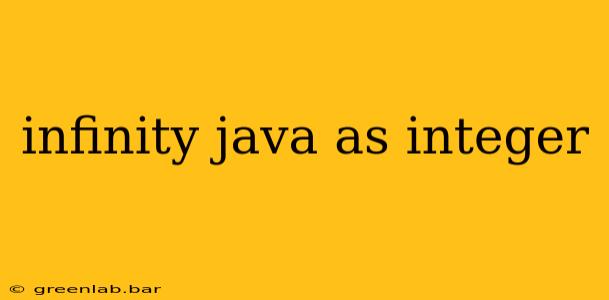Java doesn't have a built-in integer type capable of representing true infinity. Integer types like int and long have defined maximum and minimum values. Attempting to exceed these limits leads to integer overflow, resulting in unexpected and often negative values. This limitation stems from the finite nature of computer memory. However, there are ways to represent the concept of infinity in Java, depending on your specific needs.
Approaches to Representing Infinity in Java
We'll explore several ways to handle situations where you conceptually need infinity, focusing on clarity and avoiding common pitfalls.
1. Using Double.POSITIVE_INFINITY or Double.NEGATIVE_INFINITY
For floating-point arithmetic, Java offers Double.POSITIVE_INFINITY and Double.NEGATIVE_INFINITY. These constants represent positive and negative infinity, respectively. They are useful when dealing with calculations that might produce unbounded results, such as limits in calculus or certain mathematical functions.
Example:
double positiveInfinity = Double.POSITIVE_INFINITY;
double negativeInfinity = Double.NEGATIVE_INFINITY;
System.out.println(positiveInfinity); // Output: Infinity
System.out.println(negativeInfinity); // Output: -Infinity
double result = 1.0 / 0.0; // Also produces positive infinity
System.out.println(result); // Output: Infinity
Important Note: Using these constants is appropriate only when working with floating-point numbers and the context permits representing infinity as a numerical value. They should not be used for tasks involving discrete integer counts.
2. Using a Special Value to Indicate Infinity
For integer-based scenarios, defining a specific integer value to represent infinity is a common and often practical solution. This requires careful consideration:
-
Choosing a Value: Select an integer value that will never legitimately occur in your data range. For example, using
Integer.MAX_VALUEor a very large negative number (Integer.MIN_VALUE) could work, provided they won't be encountered naturally within your application's logic. -
Handling Comparisons: You need to explicitly check for this special value in your comparisons.
Example:
public class InfinityExample {
public static final int INFINITY = Integer.MAX_VALUE;
public static void main(String[] args) {
int x = 10;
int y = INFINITY;
if (y == INFINITY) {
System.out.println("Value y represents infinity.");
}
// Note that simple comparison will return a numerical result
System.out.println(x < y); // True (even though y represents infinity)
}
}
3. Using Enums for Enhanced Clarity
For improved code readability and maintainability, define an enum to represent the concept of infinity:
public enum Limit {
FINITE,
POSITIVE_INFINITY,
NEGATIVE_INFINITY
}
public class InfinityEnumExample {
public static void main(String[] args) {
Limit limit = Limit.POSITIVE_INFINITY;
switch (limit) {
case FINITE:
//Handle finite case
break;
case POSITIVE_INFINITY:
System.out.println("Limit is positive infinity.");
break;
case NEGATIVE_INFINITY:
System.out.println("Limit is negative infinity.");
break;
}
}
}
This approach enhances code clarity by explicitly representing the different states, making the code easier to understand and maintain.
Conclusion
Java lacks a direct representation of infinity for integers. The best approach depends on the specific application. For floating-point operations, Double.POSITIVE_INFINITY and Double.NEGATIVE_INFINITY are suitable. For integers, using a special value or an enum provides more control and clarity, mitigating the potential for confusion stemming from integer overflow. Always choose the method that best enhances your code’s readability and robustness.

